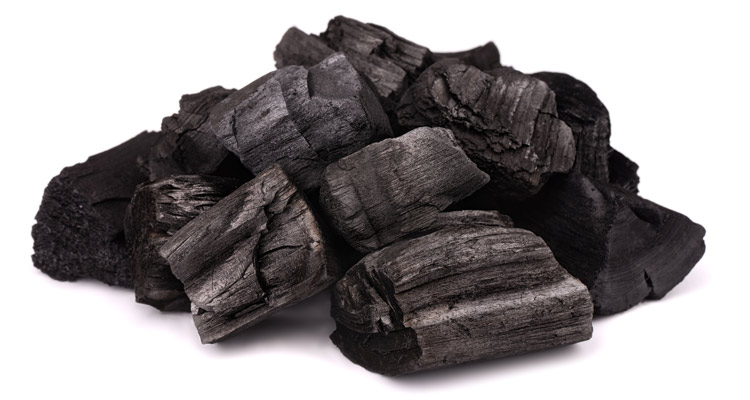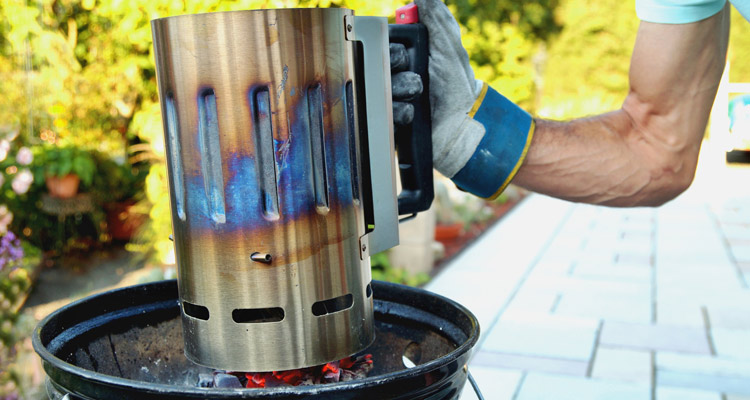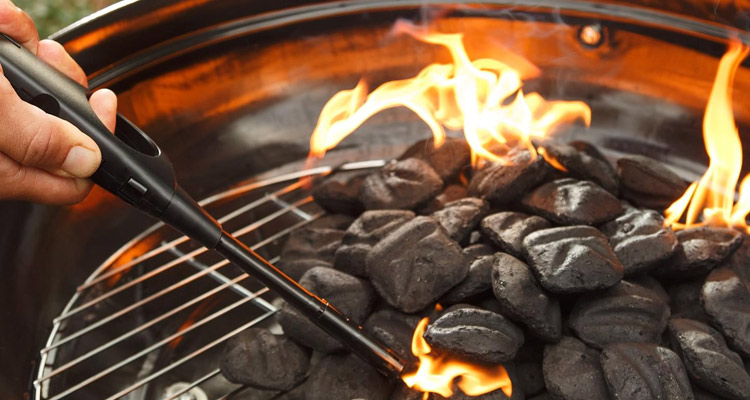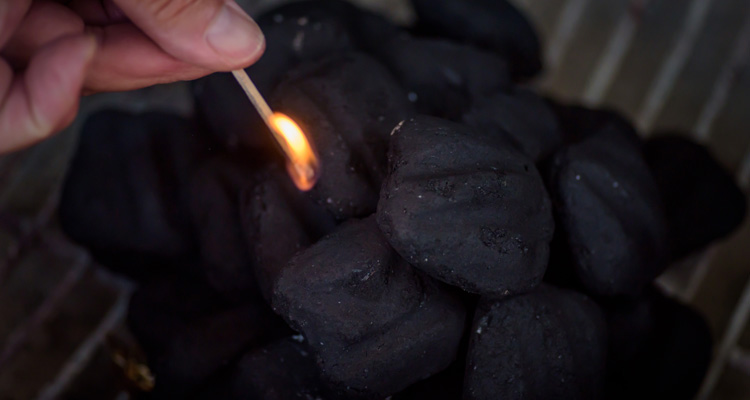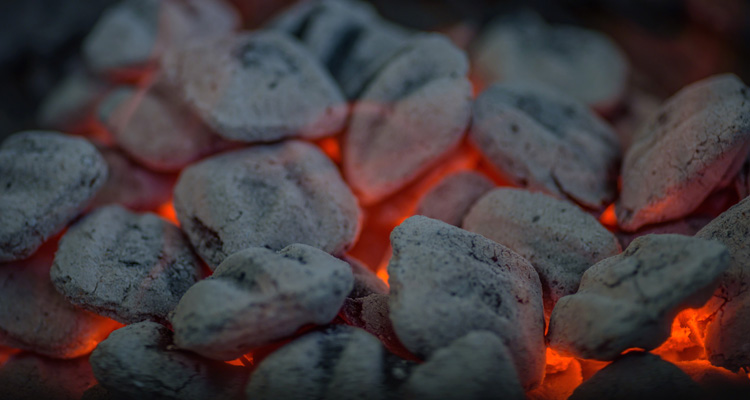Many barbecue and grilling fans depend on the humble charcoal briquettes as their fuel source when firing up the grill. No propane for many an outdoor chef — only charcoal briquettes will do.
Everyone seems to have their favorite brand of charcoal they like to buy, but are they all the same? What about lump charcoal vs. briquettes? In this article, I’ll try to give you the scoop on grilling with charcoal.
Table of Contents
The History of Charcoal Briquettes
Traditional charcoal manufacturing has been around since prehistoric times (1). However, it wasn’t until the 1920s that charcoal briquettes were brought into the mainstream.
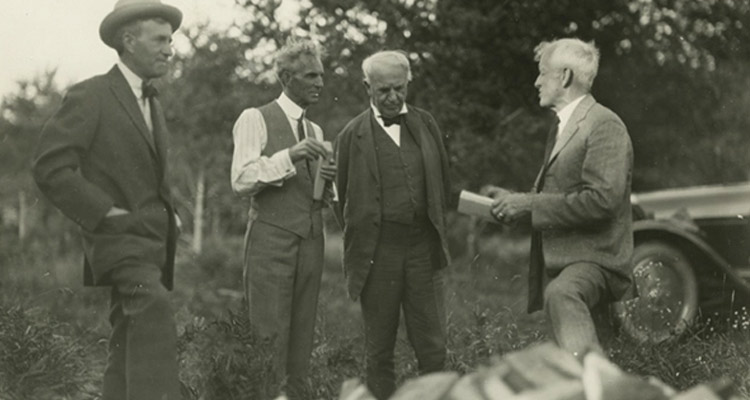
Edward G. Kingsford and Henry Ford
It was none other than Henry Ford who figured out how to make charcoal briquettes by turning wood scraps into charcoal (2).
Ford built a charcoal plant to produce the briquettes and named the company Ford Charcoal. Later, it was renamed in honor of his friend Edward G. Kingsford, who grew the company into Kingsford Products Company. It became one of the largest charcoal manufacturers in the United States and the one that many of us still use today.
How Charcoal Briquettes Are Made
Charcoal is created by cooking wood or other carbon-rich material in a low oxygen atmosphere. This process, which can take days, removes the moisture and other chemicals in the original material.
Here is a video that describes how charcoal briquettes are made:
What Is Charcoal Made Of?
Charcoal briquettes are made of scrap wood and sawdust that are likewise burned into carbon. This carbon is compressed with a starch binder and ground coal and molded into the briquette shape we all know. The uniform shape gives charcoal a nice, even heat for grilling.
Charcoal briquettes burn so slowly because the carbon (which burns) is tightly compressed, making it hard for oxygen to penetrate it. However, charcoal also burns off the binding agents and other chemicals, so some cooks prefer to barbecue with natural lump charcoal instead.
What Is Lump Charcoal?
Before the invention of BBQ briquettes, lump charcoal was king. It’s made in much the same way that charcoal bricks are made, except it contains no binders or other additives.
Lump charcoal is made by burning wood pieces in an environment without oxygen. This process helps remove all the chemicals, tree sap, and moisture from the wood, leaving you with a very clean-burning fuel source. It’s basically a piece of pure carbon that burns hotter, lights quicker, and leaves very little ash behind.
Because they’re made from natural wood pieces, lump charcoal does not have the uniform round shape of charcoal briquettes.
What Is The Difference Between Lump Charcoal and Briquettes?
In North America, briquettes tend to be preferred more than lump charcoal. They are inexpensive and available practically everywhere. They are most commonly compressed black bundles of sawdust and coal, binders, and fillers like clay and sodium nitrate. Some are presoaked in some lighter fluid for easier starts, but they can impart a chemical-like taste to food if you don’t completely burn off the lighter fluid before cooking.
Standard briquettes don’t burn as hot as lump charcoal, and the amount of smoke produced is minimal at best. But they produce predictable, even heat over a long time. A batch of 80 to 100 briquettes will last for about an hour, which is plenty of time to grill most foods without having to replenish the fire, whereas a pure lump-charcoal fire may provide only half as much grilling time before it requires more coals.
Because of the lack of added chemicals or other impurities, many people consider lump charcoal to be a natural, healthier alternative than charcoal briquettes. This is similar to how organic food is considered better for your health.
However, there is some debate whether they truly are healthier. There is not a lot of evidence that the additives in charcoal briquets affect food (3).
Lump charcoal tends to be more expensive, making them a less desirable option for someone on a budget. They also burn at a relatively high heat without the same uniform temperature as briquettes.
Personally, I prefer to use traditional charcoal briquettes because it has slower burn times and provides more control over the cooking process. However, if you’re at all concerned about the purity of your cooking material, lump charcoal may be the right option for you.
How To Light Up Charcoal Briquettes
It’s not very difficult to start charcoal briquettes, but it is helpful to know the different techniques available.
Before you begin, always remember to clean your grill out thoroughly by removing the grill and clearing out all the ash and dirt. Once this is done, you should also open up the bottom grill vents to allow air to flow in and help the charcoal burn better.
Here are the 3 methods to light up BBQ briquettes:
1. Using a Charcoal Chimney Starter
One of the most convenient ways to light up charcoal bricks is using a charcoal starter. These devices resemble metal cylinders with a handle that you stuff with newspaper and briquettes and then light the newspaper to get the coals started.
A chimney starter’s benefit is that it eliminates the need to use lighter fluid, making it a healthier and safer ignition method.
Here’s how to use one:
- Place a couple of sheets of crumpled newspaper at the bottom of the chimney.
- Set the chimney on your grill’s lower grate.
- Fill charcoal on top of the newspaper
- Ignite the paper with a lighter or match.
- Let the briquettes burn until they look white or gray, about 15-20 minutes.
2. Using an Electric Charcoal Fire Starter
Another convenient way to light the fire without chemicals is to use an electric charcoal fire starter. These handy devices lay across the charcoals and heat up to a temperature hot enough to ignite the charcoal. No chemicals or matches are needed!
To use an electric charcoal fire starter, follow these steps:
- Pile your briquettes into the center of the grill in a fairly flat formation.
- Lay the electric starter across the charcoals.
- Pile more charcoal on top of the electric starter.
- Plugin the device.
- Leave it plugged in until you see the charcoal bricks around it turning white or grey, usually between 10-15 minutes.
- Carefully remove the electric starter by its handle and hang it in a safe place to cool off.
2. Using Lighter Fluid
This is the traditional method of lighting charcoal bricks using standard briquettes and charcoal lighter fluid, and it’s also the riskiest option. You must never add lighter fluid after the fire has started. The heat will vaporize the lighter fluid and cause a serious flare-up, potentially causing injuries or burns.
To light charcoal, arrange them in a mound in the center of the grill. Add lighter fluid to coat the charcoal evenly, and let it soak in for about a minute before lighting it with a match.
3. Using Instant Lighting Charcoal Briquettes
Several brands of instant lighting BBQ briquettes are available, including the classic Kingsford Match Light Charcoal. These essentially are charcoals that have been pre-coated with the equivalent of lighter fluid. You don’t need to use any additional ignition items, making them an easy lighting alternative. You’ll be ready to cook in no time.
To use self-starting charcoal, arrange the briquettes into a mound at the center of the grill and light one of the briquettes on the edge. The fire will spread on its own to the other briquettes.
Knowing When Charcoal is Ready for Grilling
The charcoal is ready for grilling when the briquettes turn ash gray in daylight or glowing red at night. This usually takes anywhere from 20 to 30 minutes.
Here is the recommended method if you need to add additional charcoal while grilling. Add 10 or 12 briquettes to the fire’s outer edge immediately after it has been spread.
Once these coals become 80% ashed over, add to the fire’s center as needed.
How To Store Charcoal Briquettes
One good thing about charcoal is that the shelf life is indefinite so long as the briquettes are stored in a cool, dry place.
If the barbecue briquettes become damp, they will not light efficiently. If you use charcoal coated with lighter fluid (such as MatchLight), leaving the bag open will cause the solvent to evaporate. This will also prevent the briquettes from lighting properly. If your charcoal does get wet for whatever reason, you might as well throw it away because you’re going to have a heck of a time lighting it.
You can keep the charcoal in the bag, but you should make sure that the top is clipped shut after each use.
The best way I’ve found to store your charcoal is in a large plastic tub with a lid or a small trash can. A couple of five-gallon buckets (with lids) will also do the trick. If you really want to get fancy, try a coal caddy.
What Are The Best Charcoal Briquettes To Buy?
There are plenty of good options when it comes to buying charcoal briquettes. My three favorites include:
Royal Oak Charcoal Briquettes
Royal Oak Charcoal Briquettes are my favorite because they’re inexpensive, they light quickly, and they do the job well. They also have a nice smoky taste that I enjoy a lot.
[amazon box=”B016YQNWLW” link_id=”158″]
Kingsford Charcoal Briquettes
Kingsford Original Charcoal Briquettes are the granddaddy of all briquettes, started in 1920 by Henry Ford. They produce a delicious, smoky flavor and are a good option for long and slow grilling.
[amazon box=”B07MQG8VRX” link_id=”159″]
Original Natural Charcoal Briquettes
Original Naturals are designed for the elite barbecue enthusiast. These 100% natural hardwood charcoal briquettes help bring out foods’ natural flavor.
[amazon box=”B01MZYCG0X” link_id=”160″]
You can’t go wrong with any of these three brands.
Specialty Charcoals
There are several specialty charcoal variations on the market today. One of the most popular is charcoal embedded with wood chips such as Mesquite or Hickory. These add additional wood smoke flavor to the fire while cooking. These work well, and there’s no learning curve since they are used just like traditional briquettes.
Other specialty charcoals include:
Skull Charcoal Briquettes
These skull-shaped charcoals are both creepy and amazing. Now you can recreate a scene from Terminator in your own backyard!
[amazon box=”B07ZJJGQVY” link_id=”161″]
Coconut Charcoal Briquettes
Coconut charcoal is a hotter, longer-burning alternative to the traditional charcoal briquettes. It’s also very environmentally friendly. They’re made using really old coconuts, which are traditionally harder and drier than younger coconuts.
[amazon box=”B071W57VMN” link_id=”162″]
When cooking, the coconut shell barely smokes, and they can reach higher temperatures for longer amounts than regular briquettes.
Conclusion
Outdoor cooking with charcoal briquettes will always hold a special place in American tradition. The smell can remind us of good times at a park, beach, or backyard and often brings back wonderful memories.
Always remember to dispose of used coals properly in a metal ash can, and make sure they’re cool before getting rid of them!
Related content you might like:
- How to Clean a Gas Grill Properly
- Kamado vs Pellet Smoker – Which One Is Better?
- 15 Best Portable Charcoal Grills for 2024
- 15 Best Charcoal Smokers for 2024
- 10 Best Gas and Charcoal Grill Combos for 2024

